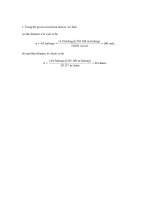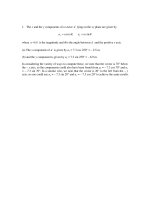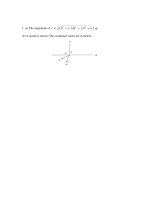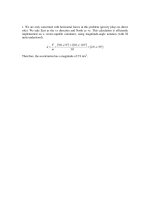Solution manual vector mechanics engineers dynamics 8th beer chapter 12
Bạn đang xem bản rút gọn của tài liệu. Xem và tải ngay bản đầy đủ của tài liệu tại đây (14.97 MB, 160 trang )
COSMOS: Complete Online Solutions Manual Organization System
Chapter 12, Solution 1.
m = 20 kg, g = 3.75 m/s 2
W = mg = ( 20 )( 3.75 )
Vector Mechanics for Engineers: Statics and Dynamics, 8/e, Ferdinand P. Beer, E. Russell Johnston, Jr.,
Elliot R. Eisenberg, William E. Clausen, David Mazurek, Phillip J. Cornwell
© 2007 The McGraw-Hill Companies.
W = 75 N W
COSMOS: Complete Online Solutions Manual Organization System
Chapter 12, Solution 2.
m = 2.000 kg W
At all latitudes,
(a) φ = 0°,
(
)
g = 9.7807 1 + 0.0053 sin 2 φ = 9.7807 m/s 2
W = mg = ( 2.000 )( 9.7807 )
(
W = 19.56 N W
)
(b) φ = 45°, g = 9.7807 1 + 0.0053 sin 2 45° = 9.8066 m/s 2
W = mg = ( 2.000 )( 9.8066 )
(
W = 19.61 N W
)
(c) φ = 60°, g = 9.7807 1 + 0.0053 sin 2 60° = 9.8196 m/s2
W = mg = ( 2.000 )( 9.8196 )
Vector Mechanics for Engineers: Statics and Dynamics, 8/e, Ferdinand P. Beer, E. Russell Johnston, Jr.,
Elliot R. Eisenberg, William E. Clausen, David Mazurek, Phillip J. Cornwell
© 2007 The McGraw-Hill Companies.
W = 19.64 N W
COSMOS: Complete Online Solutions Manual Organization System
Chapter 12, Solution 3.
Assume g = 32.2 ft/s 2
m=
W
g
ΣF = ma : W − Fs =
a
W 1 − = Fs
g
or
Fs
W =
1−
a
g
W
a
g
7
=
1−
2
32.2
W = 7.46 lb W
m=
W
7.4635
=
= 0.232 lb ⋅ s 2 /ft
g
32.2
ΣF = ma : Fs − W =
W
a
g
a
Fs = W 1 +
g
2
= 7.46 1 +
32.2
Fs = 7.92 lb W
For the balance system B,
ΣM 0 = 0: bFw − bFp = 0
Fw = Fp
a
a
But, Fw = Ww 1 + and Fp = W p 1 +
g
g
so that Ww = W p and mw =
Wp
g
Vector Mechanics for Engineers: Statics and Dynamics, 8/e, Ferdinand P. Beer, E. Russell Johnston, Jr.,
Elliot R. Eisenberg, William E. Clausen, David Mazurek, Phillip J. Cornwell
© 2007 The McGraw-Hill Companies.
mw = 0.232 lb ⋅ s 2 /ft W
COSMOS: Complete Online Solutions Manual Organization System
Chapter 12, Solution 4.
Periodic time:
τ = 12 h = 43200 s
Radius of Earth:
R = 3960 mi = 20.9088 × 106 ft
Radius of orbit:
r = 3960 + 12580 = 16540 mi = 87.33 × 106 ft
Velocity of satellite:
v=
2π r
τ
=
( 2π ) (87.33 × 106 )
43200
= 12.7019 × 103 ft/s
It is given that
(a)
mv = 750 × 103 lb ⋅ s
m=
mv
750 × 103
=
= 59.046 lb ⋅ s 2 /ft
3
v
12.7019 × 10
m = 59.0 lb ⋅ s 2 /ft W
(b)
W = mg = ( 59.046 )( 32.2 ) = 1901 lb
W = 1901 lb W
Vector Mechanics for Engineers: Statics and Dynamics, 8/e, Ferdinand P. Beer, E. Russell Johnston, Jr.,
Elliot R. Eisenberg, William E. Clausen, David Mazurek, Phillip J. Cornwell
© 2007 The McGraw-Hill Companies.
COSMOS: Complete Online Solutions Manual Organization System
Chapter 12, Solution 5.
+ ∑ Fy = ma y :
10 + 10 + 10 + 20 − 40 =
ay =
ay =
40
ay
32.2
( 32.2 )(10 ) = 8.05 ft/s2
40
dv dy dv
dv
=
=v
dt
dt dy
dy
v dv = a y d y
v
v
∫ 0 v dv = ∫ 0 a y d y
v = 2a y y =
1 2
v = ay y
2
( 2 )(8.05)(1.5)
Vector Mechanics for Engineers: Statics and Dynamics, 8/e, Ferdinand P. Beer, E. Russell Johnston, Jr.,
Elliot R. Eisenberg, William E. Clausen, David Mazurek, Phillip J. Cornwell
© 2007 The McGraw-Hill Companies.
v = 4.91 ft/s W
COSMOS: Complete Online Solutions Manual Organization System
Chapter 12, Solution 6.
Data: v0 = 108 km/h = 30 m/s, x f = 75 m
(a)
Assume constant acceleration. a = v
dv dv
=
= constant
dx dt
0
xf
∫ v0 v dv = ∫ 0 a dx
1
− v02 = a x f
2
a=−
v02
2x f
=−
(30)
( 2)( 75)
= − 6 m/s 2
0
tf
∫ v0 dv = ∫ 0 a dt
− v0 = a t f
tf = −
(b)
v0 − 30
=
a
−6
t f = 5.00 s W
+ ∑ Fy = 0: N − W = 0
N =W
∑ Fx = ma :
µ=−
µ=−
− µ N = ma
ma
ma
a
=−
=−
N
W
g
( − 6)
9.81
Vector Mechanics for Engineers: Statics and Dynamics, 8/e, Ferdinand P. Beer, E. Russell Johnston, Jr.,
Elliot R. Eisenberg, William E. Clausen, David Mazurek, Phillip J. Cornwell
© 2007 The McGraw-Hill Companies.
µ = 0.612 W
COSMOS: Complete Online Solutions Manual Organization System
Chapter 12, Solution 7.
(a)
+ ∑ F = ma :
a=−
=−
Ff
m
− F f + W sin α = ma
+
Ff
W sin α
=−
+ g sin α
m
m
(
)
7500 N
+ 9.81 m/s 2 sin 4° = − 4.6728 m/s 2
1400 kg
a = 4.6728 m/s 2
4°
v0 = 88 km/h = 24.444 m/s
From kinematics,
a=v
dv
dx
xf
0
∫ 0 a dx = ∫ v0 v dv
1
a x f = − v02
2
( 24.444 )
v02
=−
2a
( 2 )( − 4.6728)
2
xf = −
Vector Mechanics for Engineers: Statics and Dynamics, 8/e, Ferdinand P. Beer, E. Russell Johnston, Jr.,
Elliot R. Eisenberg, William E. Clausen, David Mazurek, Phillip J. Cornwell
© 2007 The McGraw-Hill Companies.
x f = 63.9 m W
COSMOS: Complete Online Solutions Manual Organization System
Chapter 12, Solution 8.
(a) Coefficient of static friction.
ΣFy = 0:
N −W = 0
N =W
v0 = 70 mi/h = 102.667 ft/s
v 2 v02
−
= at ( s − s0 )
2
2
0 − (102.667 )
v 2 − v02
=
= − 31.001 ft/s 2
2 ( s − s0 )
( 2 )(170 )
2
at =
For braking without skidding µ = µ s , so that µ s N = m | at |
ΣFt = mat : − µ s N = mat
µs = −
mat
a
31.001
= − t =
W
g
32.2
µ s = 0.963 W
(b) Stopping distance with skidding.
Use µ = µk = ( 0.80 )( 0.963) = 0.770
ΣF = mat : µk N = −mat
at = −
µk N
m
= − µk g = − 24.801 ft/s 2
Since acceleration is constant,
( s − s0 ) =
0 − (102.667 )
v 2 − v02
=
2at
( 2 )( − 24.801)
2
s − s0 = 212 ft W
Vector Mechanics for Engineers: Statics and Dynamics, 8/e, Ferdinand P. Beer, E. Russell Johnston, Jr.,
Elliot R. Eisenberg, William E. Clausen, David Mazurek, Phillip J. Cornwell
© 2007 The McGraw-Hill Companies.
COSMOS: Complete Online Solutions Manual Organization System
Chapter 12, Solution 9.
For the thrust phase,
ΣF = ma : Ft − W = ma =
W
a
g
F
2
a = g t − 1 = ( 32.2 )
− 1 = 289.8 ft/s 2
W
0.2
At t = 1 s,
v = at = ( 289.8 )(1) = 289.8 ft/s
y =
1 2 1
2
at = ( 289.8 )(1) = 144.9 ft
2
2
For the free flight phase, t > 1 s. a = − g = − 32.2 ft/s
v = v1 + a ( t − 1) = 289.8 + ( − 32.2 )( t − 1)
At v = 0,
t −1 =
289.8
= 9.00 s, t = 10.00 s
32.2
v 2 − v12 = 2a ( y − y1 ) = −2 g ( y − y1 )
0 − ( 289.8 )
v 2 − v12
=−
= 1304.1 ft
y − y1 = −
2g
( 2 )( 32.2 )
2
(a)
ymax = h = 1304.1 + 144.9
(b) As already determined,
Vector Mechanics for Engineers: Statics and Dynamics, 8/e, Ferdinand P. Beer, E. Russell Johnston, Jr.,
Elliot R. Eisenberg, William E. Clausen, David Mazurek, Phillip J. Cornwell
© 2007 The McGraw-Hill Companies.
h = 1449 ft W
t = 10.00 s W
COSMOS: Complete Online Solutions Manual Organization System
Chapter 12, Solution 10.
Kinematics: Uniformly accelerated motion. ( x0 = 0, v0 = 0 )
x = x0 + v0t +
1 2
at ,
2
a=
or
2 x ( 2 )(10 )
=
= 1.25 m/s 2
2
2
t
( 4)
ΣFy = 0: N − P sin 50° − mg cos 20° = 0
N = P sin 50° + mg cos 20°
ΣFx = ma : P cos 50° − mg sin 20° − µ N = ma
or P cos50° − mg sin 20° − µ ( P sin 50° + mg cos 20° ) = ma
P=
ma + mg ( sin 20° + µ cos 20° )
cos50° − µ sin 50°
For motion impending, set a = 0 and µ = µ s = 0.30.
P=
( 40 )( 0 ) + ( 40 )( 9.81)( sin 20° + 0.30cos 20° )
cos50° − 0.30sin 50°
= 593 N
For motion with a = 1.25 m/s 2 , use µ = µk = 0.25.
P=
( 40 )(1.25) + ( 40 )( 9.81)( sin 20° + 0.25cos 20° )
cos50° − 0.25sin 50°
P = 612 N W
Vector Mechanics for Engineers: Statics and Dynamics, 8/e, Ferdinand P. Beer, E. Russell Johnston, Jr.,
Elliot R. Eisenberg, William E. Clausen, David Mazurek, Phillip J. Cornwell
© 2007 The McGraw-Hill Companies.
COSMOS: Complete Online Solutions Manual Organization System
Chapter 12, Solution 11.
Calculation of braking force/mass ( Fb / m ) from data for level pavement.
v0 = 100 km/hr = 27.778 m/s
v 2 v02
−
= a ( x − x0 )
2
2
a=
0 − ( 27.778 )
v 2 − v02
=
2 ( x − x0 )
( 2 )( 60 )
2
= −6.43 m/s 2
ΣFx = ma : − Fbr = ma
Fbr
= −a = 6.43 m/s 2
m
(a) Going up a 6° incline. (θ = 6° )
ΣF = ma : − Fbr − mg sin θ = ma
a=−
Fbr
− g sin θ
m
= −6.43 − 9.81sin 6° = −7.455 m/s 2
0 − ( 27.778 )
v 2 − v02
=
2a
( 2 )( −7.455)
2
x − x0 =
x − x0 = 51.7 m W
(b) Going down a 2% incline. ( tan θ = −0.02, θ = −1.145° )
ΣF = ma : − Fbr − mg sin θ = ma
F
a = − br − g sin θ
m
= − 6.43 − 9.81sin ( −1.145° ) = − 6.234 m/s 2
0 − ( 27.778 )
v 2 − v02
=
2a
( 2 )( −6.234 )
2
x − x0 =
Vector Mechanics for Engineers: Statics and Dynamics, 8/e, Ferdinand P. Beer, E. Russell Johnston, Jr.,
Elliot R. Eisenberg, William E. Clausen, David Mazurek, Phillip J. Cornwell
© 2007 The McGraw-Hill Companies.
x − x0 = 61.9 m W
COSMOS: Complete Online Solutions Manual Organization System
Chapter 12, Solution 12.
Let the positive directions of x A and xB be down the incline.
Constraint of the cable:
x A + 3xB = constant
a A + 3aB = 0
1
aB = − a A
3
or
For block A:
ΣF = ma : mA g sin 30° − T = mAa A
For block B:
ΣF = ma : mB g sin 30° − 3T = mB aB = − mB a A (2)
Eliminating T and solving for
(1)
aA
,
g
( 3mA g − mB g ) sin 30° = 3mA +
mB
aA
3
( 3mA − mB ) sin 30° = ( 30 − 8) sin 30° = 0.33673
aA
=
g
3m A + mB / 3
30 + 2.667
(a) a A = ( 0.33673)( 9.81) = 3.30 m/s 2
aB = −
1
( 3.30 ) = −1.101 m/s2
3
a A = 3.30 m/s 2
30° W
a B = 1.101 m/s 2
30° W
(b) Using equation (1),
a
T = mA g sin 30° − A = (10 )( 9.81)( sin 30° − 0.33673)
g
T = 16.02 N W
Vector Mechanics for Engineers: Statics and Dynamics, 8/e, Ferdinand P. Beer, E. Russell Johnston, Jr.,
Elliot R. Eisenberg, William E. Clausen, David Mazurek, Phillip J. Cornwell
© 2007 The McGraw-Hill Companies.
COSMOS: Complete Online Solutions Manual Organization System
Chapter 12, Solution 13.
Let the positive directions of x A and xB be down the incline.
Constraint of the cable:
x A + 3xB = constant
1
aB = − a A
3
a A + 3aB = 0
ΣFy = 0: N A − mA g cos 30° = 0
Block A:
ΣFx = ma : mA g sin 30° − µ N A − T = m Aa A
Eliminate N A.
mA g ( sin 30° − µ cos 30° ) − T = mAa A
ΣFy = 0: N B − mB g cos 30° = 0
Block B:
ΣF = ma : mB g sin 30° + µ N B − 3T = mB aB = −
mB a A
3
Eliminate N B .
mB g ( sin 30° + µ cos30° ) − 3T = −
mB a A
3
Eliminate T.
( 3mA g − mB g ) sin 30° − µ ( 3mA g + mB g ) cos 30° = 3mA +
mB
aA
3
Check the value of µ s required for static equilibrium. Set a A = 0 and
solve for µ.
µ =
( 3mA − mB ) sin 30°
( 3mA + mB ) cos 30°
=
( 75 − 20 ) tan 30° = 0.334.
( 75 + 20 )
Since µ s = 0.25 < 0.334, sliding occurs.
Calculate
aA
for sliding. Use µ = µk = 0.20.
g
continued
Vector Mechanics for Engineers: Statics and Dynamics, 8/e, Ferdinand P. Beer, E. Russell Johnston, Jr.,
Elliot R. Eisenberg, William E. Clausen, David Mazurek, Phillip J. Cornwell
© 2007 The McGraw-Hill Companies.
COSMOS: Complete Online Solutions Manual Organization System
( 3mA − mB ) sin 30° − µ ( 3mA + mB ) cos 30°
aA
=
g
3mA + mB / 3
=
( 30 − 8) sin 30° − ( 0.20 )( 30 + 8) cos 30°
30 + 2.667
(a) a A = ( 0.13525 )( 9.81) = 1.327 m/s 2
1
aB = − (1.327 ) = − 0.442 m/s 2
3
= 0.13525
a A = 1.327 m/s 2
30° W
a B = 0.442 m/s 2
30° W
(b) T = mA g ( sin 30° − µ cos 30° ) − mAa A
= (10 )( 9.81)( sin 30° − 0.20cos 30° ) − (10 )(1.327 )
T = 18.79 N W
Vector Mechanics for Engineers: Statics and Dynamics, 8/e, Ferdinand P. Beer, E. Russell Johnston, Jr.,
Elliot R. Eisenberg, William E. Clausen, David Mazurek, Phillip J. Cornwell
© 2007 The McGraw-Hill Companies.
COSMOS: Complete Online Solutions Manual Organization System
Chapter 12, Solution 14.
Data:
mA =
55000 lb
= 1708.1 lb ⋅ s 2 / ft
32.2 ft/s 2
mB =
44000 lb
= 1366.5 lb ⋅ s 2 / ft
32.2 ft/s 2
v0 = − 55 mi/h = − 80.667 ft/s
(a) Use both cars together as a free body. Consider horizontal force components only. Both cars have same
acceleration.
∑ Fx = ∑ max : − Fb − Fb = mAax + mB ax
ax =
Fb + Fb
7000 + 7000
=
= 4.5534 m/s 2
mA + mB 1708.1 + 1366.5
ax = v
dv
dx
xf
0
∫ 0 ax dx = ∫ v0 v dv
ax x f =
v02
2
( −80.667 ) = − 751 ft
v2
xf = − 0 = −
2ax
( 2 )( 4.5534 )
2
715 ft to the left W
(b) Use car A as free body. Fc = coupling force.
∑ Fx = ∑ max : Fc − Fb = mAax
Fc = mAax − Fb = (1708.1)( 4.5534 ) + 7000 = 778 lb
Fc = 778 lb tension W
Vector Mechanics for Engineers: Statics and Dynamics, 8/e, Ferdinand P. Beer, E. Russell Johnston, Jr.,
Elliot R. Eisenberg, William E. Clausen, David Mazurek, Phillip J. Cornwell
© 2007 The McGraw-Hill Companies.
COSMOS: Complete Online Solutions Manual Organization System
Chapter 12, Solution 15.
mA =
55000 lb
= 1708.1 lb ⋅ s 2 / ft
32.2 ft/s 2
mB =
44000 lb
= 1366.5 lb ⋅ s 2 / ft
32.2 ft/s 2
Data:
v0 = − 55 mi/h = − 80.667 ft/s
(a) Use both cars together as a free body. Consider horizontal force components only. Both cars have same
acceleration.
∑ Fx = ∑ max : − Fb − Fb = mAax + mB ax
ax =
Fb
7000
=
= 2.2767 m/s 2
mA + mB 1708.1 + 1366.5
ax = v
∫
xf
0
dv
dx
0
ax dx = ∫ v v dv
0
ax x f =
v02
2
( −80.667 ) = 1429 ft
v02
=−
2ax
( 2 )( 2.2767 )
2
xf = −
1429 ft to the left W
(b) Use car B as a free body. Fc = coupling force.
∑ Fx = ∑ max : − Fc = mB ax
− Fc = (1366.5)( 2.2767 ) = 3110 lb
Fc = 3110 lb. compression W
Vector Mechanics for Engineers: Statics and Dynamics, 8/e, Ferdinand P. Beer, E. Russell Johnston, Jr.,
Elliot R. Eisenberg, William E. Clausen, David Mazurek, Phillip J. Cornwell
© 2007 The McGraw-Hill Companies.
COSMOS: Complete Online Solutions Manual Organization System
Chapter 12, Solution 16.
Constraint of cable:
2 x A + ( xB − x A ) = x A + xB = constant.
a A + aB = 0,
or
aB = −a A
Assume that block A moves down and block B moves up.
Block B:
ΣFy = 0: N AB − WB cosθ = 0
ΣFx = ma : − T + µ N AB + WB sin θ =
WB
aB
g
Eliminate N AB and aB .
−T + WB ( sin θ + µ cosθ ) = WB
Block A:
aB
a
= −WB A
g
g
ΣFy = 0: N A − N AB − WA cosθ = 0
N A = N AB + WA cosθ = (WB + WA ) cosθ
ΣFx = m Aa A : − T + WA sin θ − FAB − FA =
−WB ( sin θ + µ cosθ ) − WB
aA
+ WA sin θ − µWB cosθ
g
− µ (WB + WA ) cosθ = WA
(WA − WB ) sinθ
WA
aA
g
aA
g
− µ (WA + 3WB ) cosθ = (WA + WB )
aA
g
Check the condition of impending motion.
µ = µs = 0.20,
a A = aB = 0,
θ = θs
(WA − WB ) sin θ s − 0.20 (WA + 3WB ) cosθ s
=0
continued
Vector Mechanics for Engineers: Statics and Dynamics, 8/e, Ferdinand P. Beer, E. Russell Johnston, Jr.,
Elliot R. Eisenberg, William E. Clausen, David Mazurek, Phillip J. Cornwell
© 2007 The McGraw-Hill Companies.
COSMOS: Complete Online Solutions Manual Organization System
tan θ s =
0.20 (WA + 3WB ) ( 0.20 )(128 )
=
= 0.40
64
WA − WB
θ s = 21.8° < θ = 25°. The blocks move.
Calculate
aA
using µ = µ k = 0.15 and θ = 25°.
g
(WA − WB ) sin θ − µk (WA + 3WB ) cosθ
aA
=
g
WA + WB
=
64sin 25° − ( 0.15 )(128 ) cos 25°
96
= 0.10048
a A = ( 0.10048 )( 32.2 ) = 3.24 ft/s 2
(a) aB = −3.24 ft/s 2
(b)
T = WB ( sin θ + µ cosθ ) + WB
a B = 3.24 ft/s 2
25° !
aA
g
= 16 ( sin 25° + 0.15cos 25° ) + (16 )( 0.10048 )
T = 10.54 lb !
Vector Mechanics for Engineers: Statics and Dynamics, 8/e, Ferdinand P. Beer, E. Russell Johnston, Jr.,
Elliot R. Eisenberg, William E. Clausen, David Mazurek, Phillip J. Cornwell
© 2007 The McGraw-Hill Companies.
COSMOS: Complete Online Solutions Manual Organization System
Chapter 12, Solution 17.
Constraint of cable:
2 x A + ( xB − x A ) = x A + xB = constant.
a A + aB = 0,
or
aB = −a A
Assume that block A moves down and block B moves up.
Block B:
ΣFy = 0: N AB − WB cosθ = 0
ΣFx = max : − T + µ N AB + WB sin θ =
WB
aB
g
Eliminate N AB and aB .
−T + WB ( sin θ + µ cosθ ) = WB
Block A:
aB
a
= −WB A
g
g
ΣFy = 0: N A − N AB − WA cosθ + P sin θ = 0
N A = N AB + WA cosθ − P sin θ
= (WB + WA ) cosθ − P sin θ
ΣFx = mAa A : − T + WA sin θ − FAB − FA + P cosθ =
−WB ( sin θ + µ cosθ ) − WB
aA
+ WA sin θ − µWB cosθ
g
− µ (WB + WA ) cosθ + µ P sin θ + P cosθ = WA
(WA − WB ) sin θ
WA
aA
g
aA
g
− µ (WA + 3WB ) cosθ + P ( µ sin θ + cosθ ) = (WA + WB )
Check the condition of impending motion.
µ = µ s = 0.20, a A = aB = 0, θ = 25°
(WA
− WB ) sin θ − µ s (WA + 3WB ) cosθ + Ps ( µ s sin θ + cosθ ) = 0
continued
Vector Mechanics for Engineers: Statics and Dynamics, 8/e, Ferdinand P. Beer, E. Russell Johnston, Jr.,
Elliot R. Eisenberg, William E. Clausen, David Mazurek, Phillip J. Cornwell
© 2007 The McGraw-Hill Companies.
aA
g
COSMOS: Complete Online Solutions Manual Organization System
Ps =
=
µ s (WA + 3WB ) cosθ − (WA − WB ) sin θ
µ s sin θ + cosθ
( 0.20 )(128) cos 25° − 64 sin 25°
0.20 sin 25° + cos 25°
= −3.88 lb < 10 lb
Blocks will move with P = 10 lb.
Calculate
aA
using µ = µ k = 0.15, θ = 25°, and P = 10 lb.
g
(WA − WB ) sin θ − µk (WA + 3WB ) cosθ + P ( µk sinθ + cosθ )
aA
=
g
WA + WB
=
64 sin 25° − ( 0.15 )(128 ) cos 25° + (10 )( 0.15sin 25° + cos 25° )
96
= 0.20149
a A = ( 0.20149 )( 32.2 ) = 6.49 ft/s 2
(a) aB = −6.49 ft/s 2 ,
(b)
T = WB ( sin θ + µ cosθ ) + WB
a B = 6.49 ft/s 2
25° !
aA
g
= 16 ( sin 25° + 0.15cos 25° ) + (16 )( 0.20149 )
T = 12.16 lb. !
Vector Mechanics for Engineers: Statics and Dynamics, 8/e, Ferdinand P. Beer, E. Russell Johnston, Jr.,
Elliot R. Eisenberg, William E. Clausen, David Mazurek, Phillip J. Cornwell
© 2007 The McGraw-Hill Companies.
COSMOS: Complete Online Solutions Manual Organization System
Chapter 12, Solution 18.
Assume a B > a A so that the boxes separate. Boxes are slipping.
µ = µk
ΣFy = 0: N − mg cos15° = 0
N = mg cos15°
ΣFx = ma : µ k N − mg sin15° = ma
µ k mg cos15° − mg sin15° = ma
a = g ( µ k cos15° − sin15° ) ,
independent of m.
For box A, µ k = 0.30
a A = 9.81( 0.30cos15° − sin15° )
or a A = 0.304 m/s 2
15° W
For box B, µ k = 0.32
aB = 9.81( 0.32cos15° − sin15° )
Vector Mechanics for Engineers: Statics and Dynamics, 8/e, Ferdinand P. Beer, E. Russell Johnston, Jr.,
Elliot R. Eisenberg, William E. Clausen, David Mazurek, Phillip J. Cornwell
© 2007 The McGraw-Hill Companies.
or a B = 0.493 m/s 2
15° W
COSMOS: Complete Online Solutions Manual Organization System
Chapter 12, Solution 19.
Let y be positive downward position for all blocks.
Constraint of cable attached to mass A: y A + 3 yB = constant
a A + 3aB = 0
Constraint of cable attached to mass C:
a A = −3aB
yC + yB = constant
aC + aB = 0
For each block
or
or
aC = − aB
ΣF = ma :
Block A:
WA − TA = mAa A ,
or TA = WA − mAa A = WA − 3m AaB
Block C:
WC − TC = mC aC ,
or TC = WC − mC aC = WC − mC aB
Block B: WB − 3TA − TC = mB aB
WB − 3 (WA − 3mAaB ) − (WC − mC aB ) = mB aB
or
(a) Accelerations.
(b) Tensions.
aB
W − 3WA − WC
60 − 60 − 20
= B
=
= − 0.076923
g
WB + 9WA + WC
60 + 180 + 20
aB = ( − 0.076923)( 32.2 ) = − 2.477 ft/s 2
a B = 2.48 ft/s 2 W
a A = − ( 3)( − 2.477 ) = 7.431 ft/s 2
a A = 7.43 ft/s 2 W
aC = − ( − 2.477 ) = 2.477 ft/s 2
aC = 2.48 ft/s 2 W
20
( 7.43)
32.2
20
TC = 20 −
( 2.477 )
32.2
TA = 20 −
Vector Mechanics for Engineers: Statics and Dynamics, 8/e, Ferdinand P. Beer, E. Russell Johnston, Jr.,
Elliot R. Eisenberg, William E. Clausen, David Mazurek, Phillip J. Cornwell
© 2007 The McGraw-Hill Companies.
TA = 15.38 lb W
TC = 18.46 lb W
COSMOS: Complete Online Solutions Manual Organization System
Chapter 12, Solution 20.
Let y be positive downward for both blocks.
Constraint of cable: y A + yB = constant
a A + aB = 0
For blocks A and B,
aA =
aB = −a A
ΣF = ma :
Block A: WA − T =
Solving for a A ,
or
WA
aA
g
or
T = WA −
Block B: P + WB − T =
WB
W
aB = − B a A
g
g
P + WB − WA +
WA
W
a A = − B aA
g
g
WA
aA
g
WA − WB − P
g
WA + WB
(1)
2
v A2 − ( v A )0 = 2a A y A − ( y A )0
with
( v A )0 = 0
v A = 2a A y A − ( y A )0
v A − ( v A )0 = a At
t=
with
(2)
( v A )0 = 0
vA
aA
(3)
continued
Vector Mechanics for Engineers: Statics and Dynamics, 8/e, Ferdinand P. Beer, E. Russell Johnston, Jr.,
Elliot R. Eisenberg, William E. Clausen, David Mazurek, Phillip J. Cornwell
© 2007 The McGraw-Hill Companies.
COSMOS: Complete Online Solutions Manual Organization System
(a) Acceleration of block A.
System (1): WA = 100 lb,
( aA )1
By formula (1),
=
WB = 50 lb, P = 0
100 − 50
( 32.2 )
100 + 50
( a A )1 = 10.73 ft/s2
!
System (2): WA = 100 lb, WB = 0, P = 50 lb
( a A )2
By formula (1),
=
100 − 50
( 32.2 )
100
( a A )2
= 16.10 ft/s 2 !
( a A )3
= 0.749 ft/s 2 !
System (3): WA = 1100 lb, WB = 1050 lb, P = 0
By formula (1),
( a A )3
=
1100 − 1050
( 32.2 )
1100 + 1050
(b) v A at y A − ( y A )0 = 5 ft. Use formula (2).
System (1):
( v A )1
=
( 2 )(10.73)( 5)
( v A )1
= 10.36 ft/s !
System (2):
( v A )2
=
( 2 )(16.10 )( 5)
( v A )2
= 12.69 ft/s !
System (3):
( v A )3
=
( 2 )( 0.749 )( 5)
( v A )3
= 2.74 ft/s !
(c) Time at v A = 10 ft/s. Use formula (3).
System (1): t1 =
10
10.73
t1 = 0.932 s !
System (2): t2 =
10
16.10
t2 = 0.621 s !
System (3): t3 =
10
0.749
t3 = 13.35 s !
Vector Mechanics for Engineers: Statics and Dynamics, 8/e, Ferdinand P. Beer, E. Russell Johnston, Jr.,
Elliot R. Eisenberg, William E. Clausen, David Mazurek, Phillip J. Cornwell
© 2007 The McGraw-Hill Companies.
COSMOS: Complete Online Solutions Manual Organization System
Chapter 12, Solution 21.
(a) Maximum acceleration. The cable secures the upper beam; only the lower beam can move.
For the upper beam, ΣFy = 0: N1 − W = 0
N1 = W = mg
For the lower beam, ΣFy = 0: N 2 − N1 − W = 0
or
N 2 = 2W
ΣFx = ma : 0.25 N1 + 0.30 N 2 = ( 0.25 + 0.60 )W = ma
a = 0.85
W
= ( 0.85 )( 32.2 ) = 23.37 ft/s 2
m
For the upper beam,
a = 27.4 ft/s 2
!
ΣFx = ma : T − 0.25 N1 = ma
3000
T = 0.25W + ma = ( 0.25 )( 3000 ) +
( 23.37 ) = 2927 lb
32.2
T = 2930 lb !
(b) Maximum deceleration of trailer.
Case 1: Assume that only the top beam slips. As in Part (a) N1 = mg.
ΣF = ma : 0.25W = ma
a = 0.25g = 8.05 ft/s 2
continued
Vector Mechanics for Engineers: Statics and Dynamics, 8/e, Ferdinand P. Beer, E. Russell Johnston, Jr.,
Elliot R. Eisenberg, William E. Clausen, David Mazurek, Phillip J. Cornwell
© 2007 The McGraw-Hill Companies.









